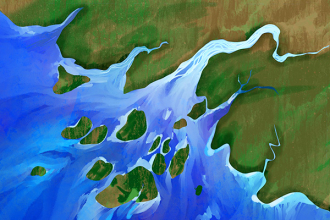太阳变化,气候变化?科普中国—科技前沿大师谈 2016-10-08 |

最近,太阳对我们地球气候的影响是气候变化背景下的一个热议话题。围绕这一问题的争论,使欧洲各地的科学家们深入研究这一论点:太阳活动可能是全球变暖主要原因。
20世纪80年代,研究表明,太阳的辐射水平在发生变化,这自然会关联到一些问题——太阳的变化会影响我们的气候吗?尽管有新的证据表明,太阳的变化确实有小的影响,但是零散的科学研究并没有涉及到如何对太阳的变化进行评估的问题。
2011年,欧洲的研究人员建立了TOSCA,一个更好地了解太阳对气候影响,应对全球变暖的国际网络。超过100位太阳物理家、地磁学,气候模型或大气化学家专家联合起来,用一种新的方式来探讨这个话题。
在此之前,太阳-地球关系的分析主要集中在测量太阳总辐射量或太阳辐射的变化上。“就好像衡量一个国家的财富只看GDP一样,” Thierry Dudok de Wit博士(法国奥尔良大学)指出。一直以来,气候研究都专注于类似的独立机制,这就是为什么TOSCA要通过将不同研究领域的更多专家联合在一起,选择整体法进行研究。
“我们最大的成就是改变了我们互动的方式,将地球-太阳能看成一个整体,而不是单独进行研究”,这次行动的领导者,Thierry Dudok de Wit博士补充说。
研究团队打算更好地了解驱动这些变化的物理和化学机制,以及它们的影响如何。理解这些机制,也有助于更好地了解太阳变化和地球气候变化之间的联系。
通过将最近的研究结果与新模型得出的结论进行对比,该网络对长期以来存在争论的假设:太阳辐射的轻微变化可能会导致地球气候变化,提出了质疑。
他们发现太阳变化的机制,可以导致区域性的气候变化,但没有一个机制会引发全球变暖。如果从超过一个世纪的时间尺度上看,太阳变化对气候变化的影响是显而易见的,但在短期内,温室气体的影响更为可观。
对于太阳-地球的联系仍然存在许多问题,其中一些问题TOSCA能够帮助解答。
通过研究太阳不同现象对气候变化的影响,研究团队发现,几个小的现象可能会产生显著影响,通常是局部影响。例如,紫外线辐射量仅占太阳能量的7%,但它的变化导致赤道附近的平流层发生变化,一直到极地,它导致了气候变化。这意味着,欧洲的冬季将变得更加湿润和温和,相反,则更加干燥和凉爽,这取决于太阳的状态。
他们还发现,被称为太阳风的电子和质子流,影响了地球的全球电场,导致气溶胶的形成,最终影响降雨的变化。这些影响,之前在很大程度上被忽略了,现在,它们将被纳入几个气候模型中,以便得出更加完整的结论。
这次行动是年轻研究者做出重要贡献的另一个例子:“如果我还能领导下一次COST Action,我会让更多的处于职业生涯早期的研究人员参与其中——他们为我们的研究团队贡献了新鲜、年轻的思维方式,” Dudok de Wit博士补充到。
本杰明 拉肯博士是TOSCA一个培训学院的领导者:“我示范用Python软件进行数据分析,并指导一个小的学生研究团队进行独立的项目研究。这有助于帮助这些学生(他们中很多人是第一次)学习关键工具和方法,这些对他们进入研究角色是非常相关的。TOSCA使我能够发现研究空白点,亲自参与研究,并了解如何有效地将我的成果与跨学科领域进行沟通和结合。感谢这个研究网络,让我在职业生涯的关键期成长为一名研究人员。”
Dudok de Wit博士在伯尔尼国家空间科学研究所的团队,以及比较项目的耦合模型,正在通过这个研究网络,利用数据集描述从1850年至今,太阳对气候变化的影响,以及到2300年的预测结果。研究结果将供政府间气候变化专门委员会编制下一份报告。专门委员会的任务是提供科学的,客观的气候变化观点及其对社会经济的影响。
其它项目都是从这个研究网络总分拆出来的,如SOLID和 VarSITI计划,这些计划将继续研究太阳对地球的影响,让欧洲科学家处于气候变化研究的前沿。
“英文原文”
A changing sun, a changing climate?
The sun's impact on our planet's climate has recently been a hotly debated topic in the context of climate change. The controversy around this issue has led scientists across Europe to dig deeper into the claim that solar activity could be a major cause of global warming.
In the 1980s, research showed that the sun's radiation levels varied, which naturally invited the question – does solar variability affect our climate? Despite new evidence that solar variability does have a small impact, scattered scientific studies have not helped improve how the sun's variations were assessed.
In 2011, European researchers set up TOSCA, a COST-funded international network aiming to offer a better understanding of the sun's effect on climate, against the backdrop of global warming. Over 100 specialists in solar physics, geomagnetism, climate modelling or atmospheric chemistry got together to explore this topic in a new way.
Previously, analyses of the sun-Earth relationship has focused on measuring the sun's total solar irradiation, or variations in solar radiation. "It's like measuring the wealth of a country only by looking at its GDP," Dr Thierry Dudok de Wit (University of Orléans, France) points out. Climate studies have long been focusing on similar mechanisms individually, which is why TOSCA opted for a global approach, by bringing on board experts from different research communities.
"Our biggest achievement was changing the way we interacted, by looking at Earth-solar connections as a whole, not individually" , adds Dr Thierry Dudok de Wit, leading the Action.
The group set out to get a better idea of the physical and chemical mechanisms driving such variations , and how impactful they were. Understanding their mechanisms also helps paint a better picture of the link between solar variability and climate change.
By comparing recent measurements with results from new models, the network challenged the long-debated assumption that the sun's slight change in radiation could cause the Earth's climate to change.
They found mechanisms by which solar variation can alter climate variability regionally , but none that would trigger global warming. Looking at time scales longer than a century, the impact of solar variability on climate change is evident, but the effect of greenhouse gases has been proven much more considerable in the short run.
However, there are still many questions behind the sun-Earth connection, some of which TOSCA helped answer.
By examining the different phenomena defining the solar impact on climate in general , the team showed several subtle phenomena could have a significant impact, often locally. For instance, UV radiation amounts to a mere 7% of solar energy, but its variation produces changes in the stratosphere near the Equator, all the way to the polar regions, which govern climate. This means that winters in Europe would become wetter and milder or, on the contrary, drier and cooler, depending on the sun's state.
They also found that streams of electrons and protons known as the solar wind, affecting the Earth's global electric field, lead to changes in aerosol formation, which ultimately impact rainfall. These effects, largely ignored so far, will now be incorporated into several climate models in order to build a more complete picture.
The Action was another example of young researchers' essential contribution: "If I were to lead another COST Action, I would get even more early career researchers involved – it was bright, young minds who made the difference in our group," Dr Dudok de Wit added.
Dr Benjamin Laken had a leading role in one of TOSCA's training schools: "I demonstrated the use of Python for data analytics, and also guided a small team of students through an independent research project. This helped expose the students – many for the first time – to critical tools and methods relevant to their development into research. TOSCA enabled me to identify the most pressing knowledge gaps, which I could personally contribute to, and see how to effectively communicate my findings back to an interdisciplinary community. Thanks to the network, I was able to grow as a researcher at a critical time in my career."
Dr Dudok de Wit's team at the International Space Science Institute in Bern, and the Coupled Model Intercomparison Project, have been using the datasets identified through the network to describe the sun's influence on climate from 1850 up to the present day, as well as a forecast up to the year 2300. The findings will shape the next report prepared by the Intergovernmental Panel on Climate Change. The panel is tasked with providing a scientific, objective view of climate changeand its socio-economic effects.
Other projects spinning off from the network, such as SOLID and VarSITI , will continue research on the sun's terrestrial impact, placing European experts at the forefront of climate studies research.
责任编辑:lijia
 科普中国APP
科普中国APP
 科普中国微信
科普中国微信
 科普中国微博
科普中国微博

科普中国—科技前沿大师谈
是中国科协为深入推进科普信息化建设而塑造的全新品牌,旨在以科普内容建设为重点,充分依托现有的传播渠道和平台,使科普信息化建设与传统科普深度融合,以公众关注度作为项目精准评估的标准,提升国家科普公共服务水平。
最新文章
-
为何太阳系所有行星都在同一平面上旋转?
新浪科技 2021-09-29
-
我国学者揭示早期宇宙星际间重元素起源之谜
中国科学报 2021-09-29
-
比“胖五”更能扛!我国新一代载人运载火箭要来了
科技日报 2021-09-29
-
5G演进已开始,6G研究正进行
光明日报 2021-09-28
-
“早期暗能量”或让宇宙年轻10亿岁
科技日报 2021-09-28
-
5G、大数据、人工智能,看看现代交通的创新元素
新华网 2021-09-28













